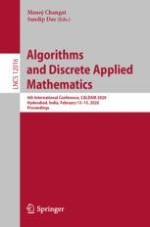2020 | OriginalPaper | Chapter
Oriented Diameter of Star Graphs
Authors : K. S. Ajish Kumar, Deepak Rajendraprasad, K. S. Sudeep
Published in: Algorithms and Discrete Applied Mathematics
Publisher: Springer International Publishing
Activate our intelligent search to find suitable subject content or patents.
Select sections of text to find matching patents with Artificial Intelligence. powered by
Select sections of text to find additional relevant content using AI-assisted search. powered by
